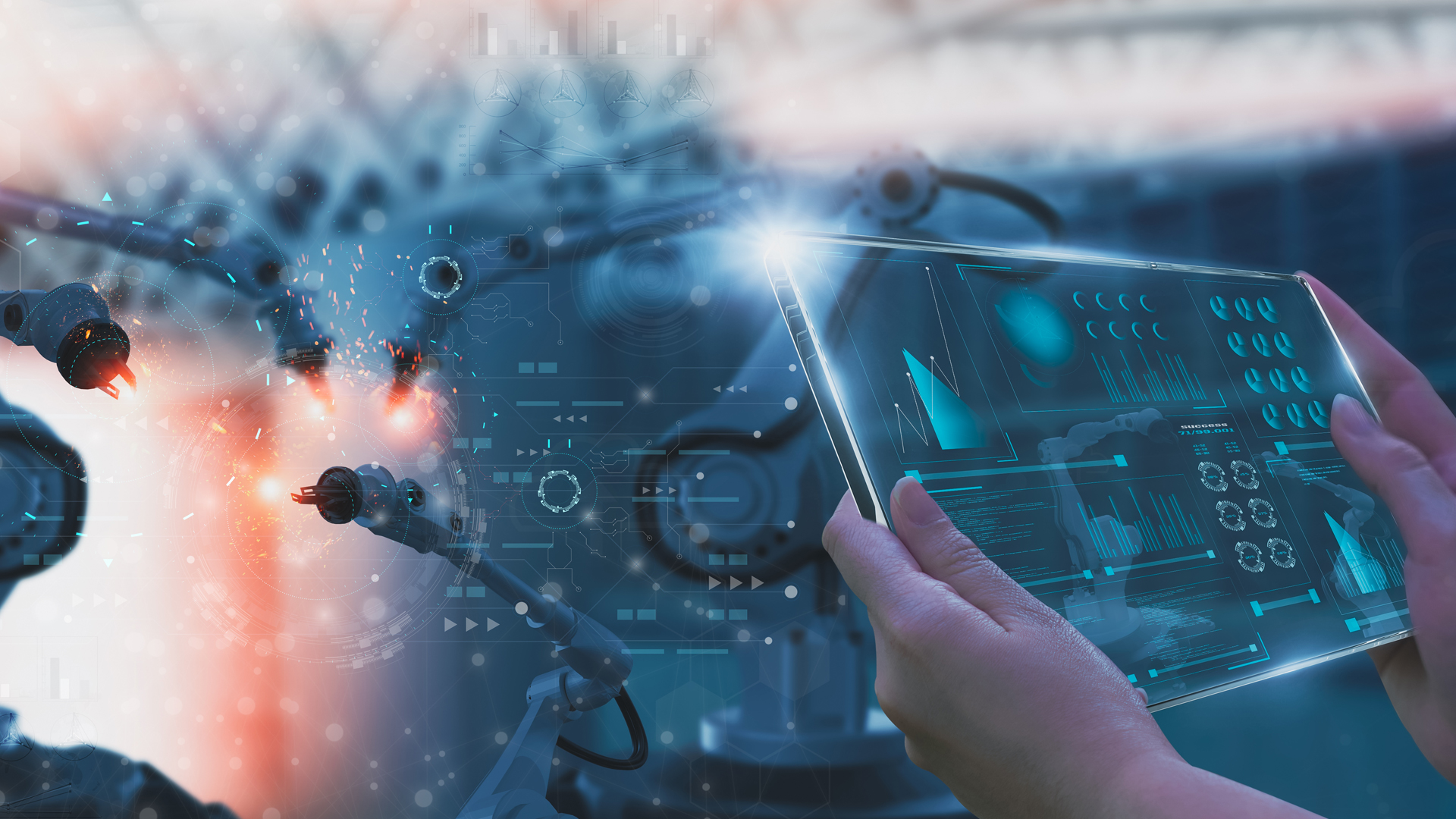Aug 22, 2023
Apples and Oranges?—Why Standards Are Important for Industry 4.0
Making business processes, especially those related to production, more efficient is the daily challenge of Neoception. But what can concrete approaches for the production of tomorrow look like and what role does the digital twin play in this? Adrian Trabold answered our questions.

When Adrian Trabold looks out the window of his office at the Neoception site in Mannheim, he can see all kinds of manufacturing companies in the distance—from small businesses to large corporations. As Director of Sales Excellence, he asks himself every day how he can help small and medium-sized companies in particular to make their manufacturing processes more efficient and to act more sustainably. Because while on the one hand more efficiency in production can save time and money, legislators are also increasingly demanding compliance with sustainability targets and proof of the sustainability of individual products. For both, transparency along the entire supply chain of product is a prerequisite. With the Neoception® Digital Twin Infrastructure, the Pepperl+Fuchs start-up Neoception supports companies to collect the corresponding data and make it centrally available in a format standardized by the industry, so that it can be used not only by the manufacturing companies themselves, but also by their customers and other stakeholders. We talked with Adrian Trabold about what exactly is behind it and what advantages companies have when they call on the support of Neoception.
Adrian, what exactly does the buzzword “digital twin” mean?
Adrian Trabold
The digital twin is a virtual representation of a specific asset—that is a physical product, a plant, process, or system. However, this should not be thought of simply as an image, because the digital twin is much more. The term "administration shell" (AAS), which is used in connection with Industry 4.0 and describes a standard for a digital twin, fits very well here: In a digital place, all information that exists for this specific asset is made available in a standardized format. In addition to product information, manuals and datasheets, this will also include real-time data, simulations, and analyses in the future.
Do you have a tangible real-world example for us to get a better idea?
Adrian Trabold
A classic illustrative example, which we are also currently working on together with Pepperl+Fuchs for the company's own product portfolio, is the digital nameplate of a product. Imagine you are a technician in a plant and you have to service a machine, but you don't want to carry around manuals that you then have to go through. It's much more convenient if you can simply take your smartphone and scan a QR code on the respective product, which gives you access to all the information you need about that specific product, such as technical data, maintenance instructions or certifications. This is exactly what the Asset Administration Shell does: it provides direct access to all this data on an asset. This not only saves time, but also material and money.

Why do we need standards for all this data?
Adrian Trabold
If you think about the supply chain of a product, it becomes clear that many different companies are involved here. From various raw material suppliers to the manufacturer and intermediary to the consumer—and strictly speaking, even the disposal company is part of it at the end. In order to ensure a consistently transparent supply chain and to be able to report on it, as required by new legislation, all parties must make the relevant data available. Defined standards are needed to ensure that this data can be used, processed, and compared in the same way. If each company provides its data in different formats for this purpose, they are difficult to interpret. This means that at the end of the day we are comparing apples and oranges and have a wild hodgepodge of data. Standards are therefore absolutely necessary here, especially if the Product Carbon Footprint, or PCF for short, also has to be verified in the future in accordance with the EU Green Deal. So we don't just need the data itself, we also need it in a standardized format so that in the future machines and plants will all speak the same language—and preferably on a global scale.

With the Neoception Digital Twin Infrastructure, we provide the appropriate infrastructure to break down existing data silos and make data centrally available, but above all, usable.
Adrian Trabold, Director of Sales Excellence at Neoception
How do you get all this data from your customers and how do you implement the standards with them?
Adrian Trabold
For many customers, the required data is usually already available, for example in ERP or PIM systems. They just don't use it yet and accordingly don't provide it in standardized formats. This is exactly where Neoception provides support. Together with our customers, we first analyze what data is already available, what data needs to be made available, and how we can use it. With the Neoception Digital Twin Infrastructure, we provide the appropriate infrastructure to break down existing data silos and make data centrally available, but above all usable. In doing so, we go through all the necessary steps with our customers—from consulting to implementation and integration into customer-specific systems and infrastructures.
How can you imagine this in detail?
Adrian Trabold
This is already going into great technical detail. Imagine that the asset administration shell is structured in different submodels, for example the submodel "digital type plate". Templates have already been created for some of these submodels, while others are still in the process of being created. In our customers' inventory data are the values that need to be assigned to these templates. And that is exactly what we do: We perform a kind of automated mapping between the asset administration shell structures and the data. Of course, this is a much more complex process than it sounds now. Because in order for all machines to speak the same language, as mentioned, we have to ensure with our solutions that relevant vocabulary is used and correctly mapped. This is the only way for machines to communicate with each other.
How do you ensure that your customers' machines and systems speak the same language as those of other companies?
Adrian Trabold
To this end, we are working very closely with various networks and partners who are committed precisely to creating cross-company and cross-industry standards. These include, for example, the ECLASS association, which focuses on semantics, the Industrial Digital Twin Association e.V. (IDTA), the Industry 4.0 platform and the ZVEI, as well as many others. The close cooperation and trusted partnership with all these networks and associations ensure that we can be pioneers, that we align our solutions with the recognized standards and thereby implement them for our customers as well.
And how do your customers ultimately benefit from collecting and making their data available in standardized formats?
Adrian Trabold
Our customers benefit from the standards in many ways. On the one hand, they are of course important if I have products from different manufacturers installed in my plant and I want to bring their data together centrally—they should of course be available in a uniform format so that I can use them and link them together. Approaches such as the digital nameplate also save material and time because, for example, paper documentation is no longer necessary and all information can be accessed digitally. On the other hand, our customers can in turn provide their customers with corresponding data in asset administration shells, which then also benefit from availability and greater efficiency. This also includes the latest firmware updates, for example. And finally, if we look one level higher at the entire supply chain, which should be transparent and comparable throughout, a standardized data format is imperative.
So, more data offers real added value?
Adrian Trabold
Exactly, that's the way to put it. More data in the form of standardized management shells offer real added value not only for the individual company but for the entire industry, and ultimately we all benefit from operating more efficiently and sustainably as a whole.